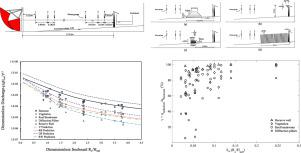当前位置:
X-MOL 学术
›
Appl. Ocean Res.
›
论文详情
Our official English website, www.x-mol.net, welcomes your
feedback! (Note: you will need to create a separate account there.)
Enhancing climate resilience of vertical seawall with retrofitting - A physical modelling study
Applied Ocean Research ( IF 4.3 ) Pub Date : 2020-10-01 , DOI: 10.1016/j.apor.2020.102331 S. Dong , S. Abolfathi , M. Salauddin , Z.H. Tan , J.M. Pearson
Applied Ocean Research ( IF 4.3 ) Pub Date : 2020-10-01 , DOI: 10.1016/j.apor.2020.102331 S. Dong , S. Abolfathi , M. Salauddin , Z.H. Tan , J.M. Pearson

|
Abstract Coastal defence structures are playing a vital role in protecting coastal communities from extreme climatic conditions and flooding. With climate change and sea-level rise in the next decades, the freeboard of existing coastal defences is likely to be reduced and the probability of wave overtopping for these coastal defences will increase. The wave overtopping from coastal defences increases the probability of coastal inundation and flooding, imposing threat to the communities which are living in low-lying coastal areas. Retrofitting of existing seawalls offers the potential to enhance coastal resilience by allowing them to adapt and respond to changing climatic conditions. This study investigates a range of possible physical configurations and optimum retrofit geometry to maximize the protection of existing seawalls from wave overtopping. A comprehensive physical modelling study of four retrofit prototypes, including recurve wall, model vegetation, reef breakwater and diffraction pillars, was conducted to examine their performance in mitigating wave overtopping, when placed in front of a vertical seawall. All the tests were conducted on 1:20 smooth beach slope. Each test case consisted of approximately 1000 pseudo-random waves based on the JONSWAP spectrum. The physical modelling experiments were designed to include both impulsive and non-impulsive wave conditions. This study provides new predictive relations and decision support tool needed to evaluate overtopping risks from existing seawalls with retrofits under various hydrodynamic conditions. The analysis of experimental measurements demonstrates that wave overtopping from retrofitting structures can be predicted with similar relations for vertical seawalls, and by using a reduction factor which varies with geometric shapes. Statistical measures and sensitivity analysis show that recurve walls have the best performance in reduction of wave overtopping volume followed by model vegetation and reef breakwater. The measurements show the insignificance of diffraction pillars, at least for the selected configurations investigated, in mitigating wave overtopping.
中文翻译:

通过改造提高垂直海堤的气候适应能力——物理模型研究
摘要 海防结构在保护沿海社区免受极端气候条件和洪水侵袭方面发挥着至关重要的作用。随着未来几十年气候变化和海平面上升,现有海防的干舷可能会减少,这些海防发生海浪翻越的可能性将增加。海浪漫过海防增加了沿海淹没和洪水的可能性,对生活在沿海低洼地区的社区构成威胁。现有海堤的改造提供了增强沿海复原力的潜力,使它们能够适应和应对不断变化的气候条件。本研究调查了一系列可能的物理配置和最佳改造几何形状,以最大限度地保护现有海堤免遭海浪漫溢。对四个改造原型(包括反曲墙、模型植被、礁石防波堤和绕射柱)进行了全面的物理建模研究,以检查它们在放置在垂直海堤前时减轻波浪漫顶的性能。所有测试均在 1:20 平滑的海滩斜坡上进行。每个测试用例由大约 1000 个基于 JONSWAP 频谱的伪随机波组成。物理建模实验被设计为包括冲击波和非冲击波条件。这项研究提供了新的预测关系和决策支持工具,用于评估在各种水动力条件下进行改造的现有海堤的越过风险。实验测量的分析表明,可以使用类似的垂直海堤关系,并通过使用随几何形状变化的折减系数来预测来自改造结构的波浪漫顶。统计措施和敏感性分析表明,反曲墙在减少波浪漫溢量方面表现最好,其次是模型植被和礁石防波堤。测量结果表明,至少对于所研究的选定配置而言,衍射柱在减轻波浪越顶方面的意义不大。
更新日期:2020-10-01
中文翻译:

通过改造提高垂直海堤的气候适应能力——物理模型研究
摘要 海防结构在保护沿海社区免受极端气候条件和洪水侵袭方面发挥着至关重要的作用。随着未来几十年气候变化和海平面上升,现有海防的干舷可能会减少,这些海防发生海浪翻越的可能性将增加。海浪漫过海防增加了沿海淹没和洪水的可能性,对生活在沿海低洼地区的社区构成威胁。现有海堤的改造提供了增强沿海复原力的潜力,使它们能够适应和应对不断变化的气候条件。本研究调查了一系列可能的物理配置和最佳改造几何形状,以最大限度地保护现有海堤免遭海浪漫溢。对四个改造原型(包括反曲墙、模型植被、礁石防波堤和绕射柱)进行了全面的物理建模研究,以检查它们在放置在垂直海堤前时减轻波浪漫顶的性能。所有测试均在 1:20 平滑的海滩斜坡上进行。每个测试用例由大约 1000 个基于 JONSWAP 频谱的伪随机波组成。物理建模实验被设计为包括冲击波和非冲击波条件。这项研究提供了新的预测关系和决策支持工具,用于评估在各种水动力条件下进行改造的现有海堤的越过风险。实验测量的分析表明,可以使用类似的垂直海堤关系,并通过使用随几何形状变化的折减系数来预测来自改造结构的波浪漫顶。统计措施和敏感性分析表明,反曲墙在减少波浪漫溢量方面表现最好,其次是模型植被和礁石防波堤。测量结果表明,至少对于所研究的选定配置而言,衍射柱在减轻波浪越顶方面的意义不大。











































 京公网安备 11010802027423号
京公网安备 11010802027423号